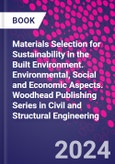Materials Selection for Sustainability in the Built Environment: Environmental, Social and Economic Aspects presents the current state-of-the-art when it comes to the decision-making process for choosing construction materials to deliver sustainable construction projects. Aspects covered include the science of enhanced decision-making via operational research and machine learning techniques and how this can be implemented in various disciplines such as architecture, engineering and construction. To this end, the book discusses environmental, economic and social aspects in assessing construction materials and presents different tools and methods that can benefit and facilitate this process.
Finally, the book reviews previous publications on construction material selection and presents essential discussions on the role professionals, researchers, contractors and governments play in making more sustainable decisions on the built environment.
Table of Contents
List of Contributors Table of Contents Preface Introduction The triple-bottom-line perspective and its importance for the Built Environment Importance of Material Selection to achieve sustainable construction Importance of decision-making in materials selection Employing circular economy principles to enhance sustainability in the Built Environment Standards and legal regulations regarding sustainable construction Introductory overview Assessment of concrete and cementitious materials Assessment of wood Assessment of glass Concluding overview: Advancements in Building Materials Technology Life Cycle Sustainability Assessment (LCSA) applied in the Built Environment Simulation tools to assist materials choice Multicriteria decision-making methods Pareto Machine learning decision-making tools Case study I: Development of laminated wood products from Eucalyptus nitens in the Chilean context Case study II: Application of Life Cycle Sustainability Assessment in BIM in early design stages for the selection of the structural system of a residential building in Spain Case study III: Designing sustainable timber-concrete composite floor system Case study IV: Thermal and Environmental performance assessment of opaque facade systems in the early design stage: an integrated approach Case study V: Mollusk shells to replace conventional aggregates in concrete Case study VI: Insulation materials choice in building retrofitting: The Influence of social determinants in the Spanish Context Sustainable Material Choice in Construction Projects via Mathematical Programming Concluding Remarks: Future Directions and Emerging Trends in Sustainable Material Selection for the Built Environment








